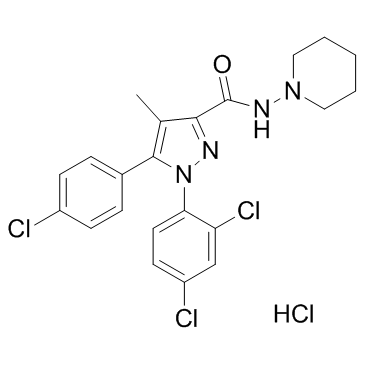Peripherally restricted CB1 receptor blockers.
Robert J Chorvat
Index: Bioorg. Med. Chem. Lett. 23(17) , 4751-60, (2013)
Full Text: HTML
Abstract
Antagonists (inverse agonists) of the cannabinoid-1 (CB1) receptor showed promise as new therapies for controlling obesity and related metabolic function/liver disease. These agents, representing diverse chemical series, shared the property of brain penetration due to the initial belief that therapeutic benefit was mainly based on brain receptor interaction. However, undesirable CNS-based side effects of the only marketed agent in this class, rimonabant, led to its removal, and termination of the development of other clinical candidates soon followed. Re-evaluation of this approach has focused on neutral or peripherally restricted (PR) antagonists. Supporting these strategies, pharmacological evidence indicates most if not all of the properties of globally acting agents may be captured by molecules with little brain presence. Methodology that can be used to eliminate BBB penetration and the means (in vitro assays, tissue distribution and receptor occupancy determinations, behavioral paradigms) to identify potential agents with little brain presence is discussed. Focus will be on the pharmacology supporting the contention that reported agents are truly peripherally restricted. Notable examples of these types of compounds are: TM38837 (structure not disclosed); AM6545 (8); JD5037 (15b); RTI-12 (19). Copyright © 2013 Elsevier Ltd. All rights reserved.
Related Compounds
| Structure | Name/CAS No. | Molecular Formula | Articles |
|---|---|---|---|
 |
SR 141716A
CAS:158681-13-1 |
C22H22Cl4N4O |
|
Obesity drug therapy.
2013-09-01 [Minerva Endocrinol. 38(3) , 245-54, (2013)] |
|
Anandamide-CB1 receptor signaling contributes to postnatal e...
2013-04-10 [J. Neurosci. 33(15) , 6350-66, (2013)] |
|
Reduced food intake is the major contributor to the protecti...
2013-09-01 [Yonsei Med. J. 54(5) , 1127-36, (2013)] |
|
Rimonabant dimorphism and its pressure-temperature phase dia...
2013-07-01 [J. Pharm. Sci. 102(7) , 2311-21, (2013)] |
|
Role of adiponectin in the metabolic effects of cannabinoid ...
2014-02-15 [Am. J. Physiol. Endocrinol. Metab. 306(4) , E457-68, (2014)] |